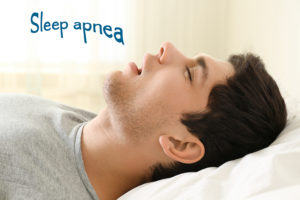Is it Snoring or Sleep Apnea?

“I have sleep apnea, I snore!”…..a claim made by many and they may just be correct. Snoring and suffering from sleep apnea are two different things. So, are you experience snoring or sleep apnea?
Sleep Apnea
Sleep apnea may make it sound like you are snoring. It is a disorder which causes abnormal pauses in breathing (apneas) or very low breathing (hypopneas) during sleep. Apneas may occur if there is a lack of respiratory effort, there is a physical blockage obstructing airflow, or a combination of the two things. Obstructive Sleep Apnea (OSA) is most common.
People with OSA may not even be aware that they experience difficulty breathing when they sleep. Often, the problem is noticed by someone who sleeps in the same bed or the same room as the affected individual. If you suffer from OSA you will often feel extreme fatigue during the day and may be quite sleepy in the middle of the day.
Those with sleep apnea may take naps during the day trying to catch up on lost sleep. They may also fall asleep watching television or sitting in a car. With more extreme cases, individuals may also fall asleep in the middle of a conversation. Sleep apnea is bound to affect work performance, concentration, and motivation as well as be the cause of other behavioral of cognitive effects.
Snoring
Snoring has a different cause. Respiratory structures vibrate if there is restricted air movement during breathing while you sleep. It can be caused by the uvula, an elongated soft palate, a large tongue, or obstructions in the nasal passage.
While as many at 50% of adults snore, one in 15 will be affected by sleep apnea. Someone who snores may also have sleep apnea but not all patients with sleep apnea snore. So even if you do not snore, you may suffer from sleep apnea. A sleep study can help to determine if you suffer from sleep apnea. If you often don’t feel like you have had a good night’s sleep and you suffer from daytime sleepiness and fatigue you can go to a sleep center and stay overnight where they will connect you to a variety of devices to monitor your body. They will look at brain activity, eye movements, muscle activity, heart rhythm, and oxygen saturation. You may also use a home testing device that will do the same thing in the comfort of your home.
Treatments
There are a variety of treatment options for those suffering from snoring and obstructive sleep apnea. Snoring treatment may include positive airway pressure devices, or dental appliances and surgeries that will be customized for your needs. The Pillar Procedure is a surgery in which three to six woven polyester strips are inserted into the soft palate. This surgery is done under general anesthesia. This will help the soft palate become more rigid which will reduce vibrations and also snoring. Treatments will vary depending on the cause of the snoring or the sleep apnea.
If you have obstructive sleep apnea you may use a Continuous Positive Airway Pressure Device (CPAP) which will keep your airway open during sleep. The machine delivers a continuous flow of pressurized air into the throat. Another option is to get a custom-made mouthpiece that will help to move the lower jaw forward which will open your airway.
Whether it is snoring or sleep apnea, there are also surgery options to open your airway to make nighttime breathing easier. Surgery is individualized for each patient depending on the cause of the issue. For further information on the treatment options for snoring and sleep apnea, you can contact Samaritan Dental Arts where our team of professionals are available to help seek the best option for you.








 I have never had a better dental experience prior to my visit with Dr. Zabolian. It was pain free for the first time ever, the staff was friendly, accommodating to my schedule, there were no problems with my insurance claims... I am so happy I have found a dentist (after all these years) I feel so comfortable going to and also taking my family.
I have never had a better dental experience prior to my visit with Dr. Zabolian. It was pain free for the first time ever, the staff was friendly, accommodating to my schedule, there were no problems with my insurance claims... I am so happy I have found a dentist (after all these years) I feel so comfortable going to and also taking my family. 






